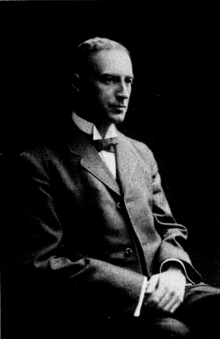 |
| Wallace Clement Sabine |
Trough experimenting, Sabine was able to determine that there was a relationship between the quality of the acoustics, the size of the chamber and the amount of surface absorption. He defined the reverberation time in to a formula, which is still the most important characteristic used for gauging the acoustical quantity of a room, as number of seconds required for the intensity of the sound to drop from the starting level, by an amount of 60 dB (decibels).
Formula:
T = (V / A) . 0,161 s
Legenda
T = The reverberation time
V = The room volume
A = The total absorption area
Life of Wallace Clement Sabine
Sabine graduated at the Ohio State Universitey in 1886 at the age of 18. After that, he joined the Harvard University and remained a faculty member. He was also the acoustical architect of the Boston's Symphony Hall that is considered one of the best concert halls in the world for it's acoustical performance.
With his formula and the study of rooms he determined that acoustically appropriate concert halls had reverberation times of 2 to 2,25 seconds. With shorter reverberation times, the music hall seems to feel too 'dry' to the listener. While the optimal reverberation for lecture is just under 1 second
New concert halls
New halls are made that way that a big peace at the top of the hall can be adjusted from place for a perfect sound according to the perpose wither it is for music or for lecture.
Legenda
T = The reverberation time
V = The room volume
A = The total absorption area
Life of Wallace Clement Sabine
Sabine graduated at the Ohio State Universitey in 1886 at the age of 18. After that, he joined the Harvard University and remained a faculty member. He was also the acoustical architect of the Boston's Symphony Hall that is considered one of the best concert halls in the world for it's acoustical performance.
With his formula and the study of rooms he determined that acoustically appropriate concert halls had reverberation times of 2 to 2,25 seconds. With shorter reverberation times, the music hall seems to feel too 'dry' to the listener. While the optimal reverberation for lecture is just under 1 second
New concert halls
New halls are made that way that a big peace at the top of the hall can be adjusted from place for a perfect sound according to the perpose wither it is for music or for lecture.